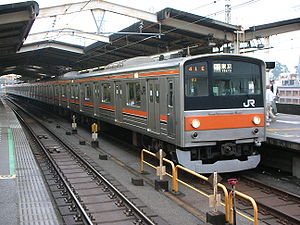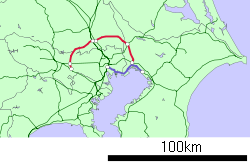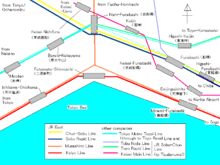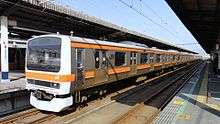- Musashino Line
-
Musashino Line
武蔵野線
205 series EMU at Nishi-Funabashi StationOverview Type Heavy rail Locale Tokyo, Kanagawa, Saitama, Chiba prefectures Termini Fuchū-Hommachi
Nishi-FunabashiOperation Opened 1973 Owner JR East Operator(s) JR East, JR Freight Rolling stock 205 series, 209-500 series EMUs Technical Line length 100.6 km (62.51 mi) Track gauge 1,067 mm (3 ft 6 in) Electrification 1,500 V DC overhead catenary Route map The Musashino Line (武蔵野線 Musashino-sen) is a railway line operated by the East Japan Railway Company (JR East). It links Tsurumi Station in Yokohama with Nishi-Funabashi Station in Chiba Prefecture, forming a 100.6 km unclosed loop around central Tokyo. Passenger operations are limited to the 71.8 km portion between Fuchū-Hommachi and Nishi-Funabashi; the Tsurumi to Fuchū-Hommachi portion, called the Musashino South Line, is normally used only by freight trains.
Contents
Services
Most services on the Musashino Line are local trains making all stops, but there are some rapid services which run on the Keiyō Line through Nishi-Funabashi to continue to Tokyo or Minami-Funabashi; others run to Kaihin-Makuhari via Minami-Funabashi.
Other services include:
- Musashino: services operated between Fuchū-Hommachi/Hachiōji and Ōmiya.
- Shimōsa: services operated between Ōmiya and Nishi-Funabashi.
Station list
Tsurumi Station is considered to be the origin of the Musashino Line; trains going clockwise (toward Nishi-Funabashi) are therefore referred to as heading "down" (下り kudari), while trains going counter-clockwise (toward Fuchū-Hommachi) are heading "up" (上り nobori). This is often counterintuitive, as it results in through trains to Tokyo being labeled and numbered as "down" trains while on the Musashino Line; however, such trains switch to "up" after joining the Keiyō Line.
All passenger trains begin service at Fuchū-Hommachi Station; details on the Musashino South Line freight-only section can be found below the passenger station list.
Musashino Line (passenger)
Name Japanese Distance (km) Transfers Location Between
stationsTotal Fuchū-Hommachi 府中本町 - 0.0 Nambu Line, Musashino South Line (Freight) Fuchū Tokyo Kita-Fuchū 北府中 1.7 1.7 Nishi-Kokubunji 西国分寺 2.2 3.9 Chūō Line (Rapid) Kokubunji Shin-Kodaira 新小平 3.5 7.4 Seibu Tamako Line (Ōmekaidō)
Musashino Line (Kunitachi Freight Branch)Kodaira Shin-Akitsu 新秋津 5.6 13.0 Seibu Ikebukuro Line (Akitsu) Higashimurayama Higashi-Tokorozawa 東所沢 2.7 15.7 Tokorozawa Saitama Niiza Freight Terminal 新座貨物ターミナル駅 3.7 19.4 Niiza Niiza 新座 0.3 19.7 Kita-Asaka 北朝霞 3.1 22.8 Tōbu Tōjō Line (Asakadai) Asaka Nishi-Urawa 西浦和 5.0 27.8 Musashino Line (Ōmiya Freight Branch) Sakura-ku, Saitama Musashi-Urawa 武蔵浦和 2.0 29.8 Saikyō Line
Musashino Line (Nishi-Urawa Freight Branch)Minami-ku, Saitama Minami-Urawa 南浦和 1.9 31.7 Keihin-Tōhoku Line Higashi-Urawa 東浦和 3.7 35.4 Midori-ku, Saitama Higashi-Kawaguchi 東川口 3.8 39.2 Saitama Rapid Railway Line Kawaguchi Minami-Koshigaya 南越谷 4.3 43.5 Tōbu Isesaki Line (Shin-Koshigaya) Koshigaya Koshigaya Freight Terminal 越谷貨物ターミナル駅 0.4 43.9 Koshigaya-Laketown 越谷レイクタウン 2.4 46.3 Yoshikawa 吉川 1.9 48.2 Yoshikawa Yoshikawa-Minami (opening spring 2012) 吉川美南 1.7 49.9 Shin-Misato 新三郷 1.4 51.3 Misato Misato 三郷 2.1 53.4 Minami-Nagareyama 南流山 2.0 55.4 Tsukuba Express
Musashino Line (Kita-Kogane, Mabashi Freight Branches)Nagareyama Chiba Shin-Matsudo 新松戸 2.1 57.5 Jōban Line
Sōbu Nagareyama Line (Kōya)Matsudo Shin-Yahashira 新八柱 4.1 61.6 Shin-Keisei Line (Yabashira) Higashi-Matsudo 東松戸 2.4 64.0 Hokusō Line Ichikawa-Ōno 市川大野 1.9 65.9 Ichikawa Funabashi-Hōten 船橋法典 3.0 68.9 Funabashi Nishi-Funabashi 西船橋 2.9 71.8 Sōbu Line (Local), Keiyō Line (through to Tōkyō, Kaihin-Makuhari)
Tokyo Metro Tōzai Line (T-23)
Tōyō Rapid Railway Line
Keisei Main Line (Keisei-Nishifuna)Ōmekaidō Station is approximately 10 minutes walk from Shin-Kodaira Station.
Musashino South Line (freight)
Name Japanese Distance (km) Transfers Location Between
StationsTotal Tsurumi 鶴見 - 0.0 Tōkaidō Line, Keihin Tohoku Line, Tsurumi Line, Tōkaidō Freight Line, Takashima Freight Line Tsurumi-ku, Yokohama Kanagawa Shin-Tsurumi Signalbox
(formerly Shin-Tsurumi Yard)新鶴見信号場 3.9 3.9 Hinkaku Line, Nambu Line Freight Branch (for Shitte) Kajigaya Freight Terminal 梶ヶ谷貨物ターミナル駅 8.8 12.7 Miyamae-ku, Kawasaki Fuchū-Hommachi 府中本町 16.1 28.8 Musashino Line (towards Nishi-Kokubunji), Nambu Line Fuchū Tokyo Rolling stock
Current
Trains on the Musashino Line are normally formed of 205 series and 209-500 series 8-car electric multiple units.
Previous
Rolling stock previously used includes 101-1000 series 6-car EMUs, 201 series 6-car EMUs, and 103 series 8-car EMUs (until 2005).
165 and 169 series EMUs were used on Shinkansen Relay services and later Musashino rapid services until 2002. 115 series EMUs were used on Musashino services from 2002 until the services were downgraded to all-stations "Local" status in December 2010.
Freight
Locomotive types seen hauling freight trains include the EF64, EF65, EF66, EF81, EF200, EF210, EH200, EH500, and DE10.
History
The Musashino Line was initially envisioned as a "Tokyo Outer Loop Line" in a 1927 railway appropriations bill, but was not built for several decades due to World War II and its aftermath. Construction finally began in 1964.
In 1967, a train carrying jet fuel to Tachikawa Air Base in western Tokyo exploded while passing through Shinjuku Station. This disaster led to the banning of freight trains on railway lines in central Tokyo and sped the development of the Musashino Line as an alternative route. Because most of the line passed through sparsely populated areas, it was initially envisioned as a freight-only line: however, opposition from local residents, at the same time as the violent landowner battles plaguing Narita International Airport, led the railway authorities to agree to passenger service as well.
The northern portion of the line (Fuchū to Funabashi) was completed in 1973; the southern freight-only portion (Fuchū to Tsurumi) was completed in 1976. The line remains in use for transporting US military jet fuel from Yokohama to west Tokyo, among other purposes.
See also
 Media related to Musashino Line at Wikimedia Commons
Media related to Musashino Line at Wikimedia CommonsReferences
External links
- Stations of the Musashino Line (JR East) (Japanese)
JR East lines Shinkansen 
Main Local Agatsuma · Akabane · Aterazawa · Ban'etsu East · Ban'etsu West · Echigo · Gonō · Hachikō · Hachinohe · Hakushin · Hanawa · Iiyama · Ishinomaki · Itō · Itsukaichi · Iwaizumi · Jōban · Jōetsu · Kamaishi · Karasuyama · Kashima · Kawagoe · Keiyō · Kesennuma · Kitakami · Koumi · Kururi · Mito · Musashino · Nambu · Narita · Negishi · Nikkō · Ōfunato · Oga · Ōito · Ōme · Ōminato · Rikuu East · Rikuu West · Ryōmō · Sagami · Senseki · Senzan · Shinonoi · Sotobō · Suigun · Tadami · Takasaki · Tazawako · Tōgane · Tsugaru · Tsurumi · Uchibō · Yahiko · Yamada · Yamanote · Yokohama · Yokosuka · YonesakaOthers Chūō Rapid · Chūō-Sōbu · Gala-Yuzawa · Keihin-Tōhoku · Saikyō · Shōnan-Shinjuku · Sōbu Rapid · (Tōhoku Jūkan - under construction)Past Categories:- Lines of East Japan Railway Company
- Rail transport in Kanagawa Prefecture
- Rail transport in Tokyo
- Rail transport in Saitama Prefecture
- Rail transport in Chiba Prefecture
- 1067 mm gauge railways in Japan
Wikimedia Foundation. 2010.



